- Home
- Ann M. Martin
Class Play
Class Play Read online
This book is in honor of
the birth of
Laura Caroline Hemphill
CONTENTS
TITLE PAGE
DEDICATION
1 LESLIE MORRIS
2 CLASS PLAY
3 ALICE IN WONDERLAND
4 SPEAK UP!
5 TWEEDLEDUM AND TWEEDLEDEE
6 MEANIE MRS. GRAFF
7 LESLIE’S SURPRISE
8 MEANIE MOMMY
9 THE SNEAKY PLAN
10 THE THIEF
11 TATTLETALE
12 MRS. GRAFF AGAIN
13 TELLING THE TRUTH
14 BAD AND GOOD
15 BRAVO!
ABOUT THE AUTHOR
COPYRIGHT
LESLIE MORRIS
“Hello, Barf-head,” Leslie Morris called. She slammed the car door shut. “ ’Bye, Mommy!” she said.
“ ’Bye, honey,” said Mrs. Morris. “See you this afternoon.”
Barf-head’s real name was Ricky Torres. “Hello, Stink-head,” Ricky said to Leslie.
Leslie and Ricky were in Ms. Colman’s second-grade class at Stoneybrook Academy. Ms. Colman was their favorite teacher. She almost never yelled, and she thought up very good surprises for her students. Everyone liked her (but most of the boys would not admit it).
Ricky followed Leslie along the walk to the entrance to school. He stepped on her heels as often as he could.
“Cut it out!” yelled Leslie.
She stopped short and Ricky ran into her.
“Ow!” he cried.
“Serves you right!” Leslie ran inside. Then she stopped and walked through the halls to her classroom. The kids at Stoneybrook Academy were not allowed to run in the halls.
Leslie stepped inside the room. She looked around. Ms. Colman was not there yet. But the door between Ms. Colman’s room and Mr. Berger’s second-grade room next door was open. Leslie knew Mr. Berger was keeping his eye on all the second-graders.
Only two other kids were in Ms. Colman’s room. Tammy and Terri Barkan were putting things away in their cubbies.
“Hi, Terri. Hi, Tammy,” said Leslie. Terri and Tammy were twins. Some days, Leslie could not tell them apart. Today was one of those days. The girls were wearing the same outfits, and each had pulled her hair back with blue sparkle barrettes.
Leslie sat at her desk. She peered inside it. Her desk was boring. So she decided to visit Hootie. Hootie was the class pet. He was a guinea pig. He was friendly and good company.
Leslie stood next to Hootie’s cage. She held Hootie in her arms. She watched her classmates arrive. Leslie decided to be the Morning Greeter. At least until Jannie Gilbert showed up. Jannie was Leslie’s best friend. Leslie was never bored when Jannie was around.
“Hi, Omar!” Leslie called when Omar Harris arrived. “Hi, Ian! Hi, Chris!” she said to Ian Johnson and Chris Lamar. (The boys looked surprised to be greeted by Leslie.)
“Hi, Sara! Hi, Natalie!” cried Leslie.
Sara Ford and Natalie Springer were trading sticks of chewing gum. “Hi, Leslie,” they replied. And Sara added, “Hi, Hootie.”
Next to arrive were Karen Brewer, Nancy Dawes, and Hannie Papadakis. They were best friends, just like Leslie and Jannie. They always stuck together.
“Hi,” Leslie said to them.
“Hi,” mumbled Nancy and Hannie. Karen did not say a word. She did not like Leslie. Or Jannie. And they did not like Karen. Or Nancy. Or Hannie. But especially not Karen.
Ricky Torres finally arrived. Bobby Gianelli and Hank Reubens were right behind him. “Hi, Barf-head. Hi, Barf-head. Hi, Barf-head,” Leslie greeted them.
“Hi, Stink-head,” they replied.
Soon Audrey Green arrived. Then Ms. Colman arrived. And at long last, Jannie hurried into the room.
“Where were you?” Leslie asked Jannie. She set Hootie back in his cage. “I was waiting for you.”
“Sorry,” said Jannie. “My dad’s car would not start.”
Ms. Colman clapped her hands. “Attention, please, boys and girls,” she called.
It was time to start the day.
CLASS PLAY
Leslie ran to her desk. She plopped into her chair. Jannie plopped into hers. Jannie sat in front of Leslie. Leslie had found that she could poke the ends of Jannie’s hair with her pencil, and Ms. Colman never noticed.
Ms. Colman took attendance. Then she took lunch orders. Then the kids in Ms. Colman’s class listened to the principal. He made an announcement over the P.A. system.
When he was finished, Ms. Colman said, “Girls and boys, I have an announcement of my own to make.”
Jannie turned around in her seat. She grinned at Leslie. The kids loved Ms. Colman’s announcements.
“Soon,” began Ms. Colman, “our class is going to put on a play.”
“Our whole class?” asked Chris.
“Our whole class,” replied Ms. Colman. “Every one of you will be in it. And you will all help make the costumes and scenery.”
“Yes!” cried Karen Brewer from the back of the room.
“Indoor voice, please,” Ms. Colman reminded her.
Leslie looked around the room. Most of the kids were smiling. But not all of them. Natalie was frowning. Nancy was staring down at her hands. She looked as if she might cry.
Then Ian raised his hand. “Do we have to be in it?” he asked.
Ms. Colman nodded. “Yes. It will be a good experience. But most of all, I think you will have fun.”
“But what if we do not want to be in the play?” asked Nancy.
“Then you will have a very small part. You will probably not even have to speak. Other kids will play the bigger parts.”
“What is the play, Ms. Colman?” asked Leslie. She was bouncing around in her seat. She could not sit still.
“We are going to put on,” said Ms. Colman, “Alice in Wonderland.”
“Cool,” said Hannie.
Leslie was still bouncing around in her seat. “Oh, Ms. Colman! Ms. Colman!” she cried. “My mother used to direct plays. In New York City. And I love to act.”
“Wonderful,” replied Ms. Colman. “I am glad you love to act because we are going to put on two performances of our play. The first one will be in the afternoon for the students and teachers here at school. The second will be in the evening for our parents and families and friends. We will use the stage in our auditorium.”
Audrey raised her hand. “How will you decide who gets big parts and who gets little parts?” she wanted to know.
“Actually, I will not decide that,” said Ms. Colman. “Mrs. Graff will decide.” (Mrs. Graff was one of the fifth-grade teachers.) “She is going to direct the play.”
“When will we get to try out for the play?” asked Hank.
“In just a couple of days,” replied Ms. Colman. “And now, class, it is time for reading. Please find your books and let’s begin.”
On the playground after lunch that day, Leslie and Jannie sat side by side on the swings.
“I cannot wait to try out for the play,” said Jannie.
“What part do you want?” Leslie asked her.
Jannie shrugged. “I don’t know. I just want a good costume.”
“I just want a big part,” said Leslie. Then she nudged Jannie. “Pssst. There are Karen and Hannie and Nancy.”
Karen, Nancy, and Hannie walked past the swings then. They did not see Leslie and Jannie. They were whispering. But Leslie heard Karen say, “I hope I get a big part in the play.”
ALICE IN WONDERLAND
When recess was over, the kids in Ms. Colman’s class returned to their room. They found Ms. Colman standing by her desk. She was holding up a picture book. The title of the book was Alice in Wonderland.
“This is not the whole story,” sa
id Ms. Colman as her students settled down. “Alice’s story was told in two big books. Our play cannot tell that whole, long story. It will tell only some parts of it. Those parts are lots of fun, and full of funny characters. How many of you know the story of Alice in Wonderland?” Seven kids raised their hands. Nine kids did not. “Okay,” Ms. Colman went on. “Today I am going to read you this short story about Alice. The play we put on will be very much like this story.”
The kids in the class sat still. They listened to Ms. Colman read about the girl named Alice who fell down a rabbit hole and had wonderful adventures in an imaginary land. She changed her size, she went to a mad tea party, and she met lots of strange characters — the White Rabbit whose hole she had fallen down, the Mad Hatter, the Cheshire Cat, Tweedledum and Tweedledee, the White Queen, the Red Queen, the Mock Turtle, a Caterpillar, and even more.
“What do you think?” Ms. Colman asked, when she had finished reading.
“Cool,” said Hank.
“Weird,” said Bobby.
Ms. Colman smiled. Then she said, “Are you ready to see how our play will tell Alice’s story?” On Ms. Colman’s desk were a pile of yellow booklets. She walked up and down the rows of kids. She gave one book to each student.
Leslie looked at her book. On the cover were the words Alice in Wonderland. She opened the cover. She turned the first page. She saw a list of names. It was headed Characters.
“Alice,” Leslie read to herself. “The White Rabbit. The Cheshire Cat.”
“Okay, girls and boys,” Ms. Colman went on. “Let’s read through the play now. Hannie and Ian, would you read the first page aloud? Hannie, you read Alice’s part, and Ian, you read the White Rabbit’s part.”
Hannie and Ian read. When they finished the first page, Ms. Colman said, “Do you see how the play is different from the story I just read to you? In a play, the story must be told in dialogue. That means it must be told when the characters talk to each other. It is told in conversation.”
Ms. Colman asked other kids to read other parts. Leslie saw that there were plenty of parts in the play. Enough for everyone to have a role. Some of the parts, such as the Lory, were very small. (The Lory was a funny bird.) Other parts, such as the Cheshire Cat, were much bigger. The part of Alice was the biggest of all. Leslie thought of the pictures of Alice she had seen in Ms. Colman’s books. Alice’s hair was long and blonde. She got to wear a lovely white pinafore over a blue dress. On her feet were shiny black party shoes. Some of the other characters were quite strange-looking. The Cheshire Cat, for instance, was an enormous cat who lazed about in a tree, and often became invisible, except for his huge smile. And Tweedledee and Tweedledum — well, they were especially strange. They were fat little men wearing odd suits. The suits looked alike except that one said DEE on the collar, and the other said DUM.
Leslie wrinkled her nose. “Ew,” she whispered.
“Class,” said Ms. Colman, “on Thursday we will go to the auditorium. Those of you who want to try out for the larger roles may do so. The smaller roles will be assigned to the rest of you. Don’t worry, there are plenty of big parts and small parts to go around.”
Leslie frowned. She wanted only one part, and that was Alice. She looked at Karen Brewer in the back row. She just knew that Karen wanted to be Alice, too.
SPEAK UP!
On Thursday morning, Leslie felt butterflies in her stomach. As she walked down the hall to Ms. Colman’s room, she leaned over and talked to her stomach.
“Go away, you butterflies,” she said. “Or calm down. You are making me nervous. And I do not want to be nervous today.”
“Who are you talking to, Leslie?” asked Chris as he hurried by her.
“No one,” said Leslie. She felt her face turn red.
That morning Ms. Colman said to the kids in her class, “Remember, today is the day you will try out for parts in Alice in Wonderland. Mrs. Graff is going to meet us in the auditorium after lunch.”
After lunch? thought Leslie. That is too bad. I am going to be very nervous by then. I hope I do not barf.
Leslie did not barf. No one did. As soon as the kids in Ms. Colman’s class returned from recess, Ms. Colman said, “Time to go to the auditorium. Please bring your playbooks with you.”
The kids followed Ms. Colman down the hall. They sat in the first row of seats in the auditorium. Ms. Colman stood in front of them. “Girls and boys, I want you to meet Mrs. Graff,” she said. “Mrs. Graff will be directing our play. That means she will be in charge of it. I will be her helper. Mrs. Graff has directed many school plays.”
Mrs. Graff faced Ms. Colman’s students. She was wearing a wool suit. (She looked a bit hot.) Her gray hair was combed straight down, and was neatly parted. Around her neck hung a pair of glasses on a chain. Mrs. Graff did not smile at the kids. She simply held up a playbook.
“Now. You have all read the play, so you know the story of Alice. How many of you want to try out for a part today?” she asked.
Leslie looked up and down the row. Ten kids raised their hands.
“Very well,” said Mrs. Graff. “Smaller roles will be assigned to the rest of you. Okay. Let’s get started. No sense in wasting time. The first role you may read for is the White Rabbit. Any of you who wishes to try out for the White Rabbit, please come to the stage now. Bring your playbooks with you.”
Leslie glanced at Jannie, who was sitting next to her. “She is mean,” Leslie whispered. “I don’t like her.”
“Me nei —” Jannie started to say.
“Girls! Shh!” said Mrs. Graff from the stage. “I expect everyone to pay attention. That is the only way to put on a play.”
Leslie slumped in her seat. So did Jannie. So did several other kids.
Mrs. Graff turned to the kids on the stage. “Please open your playbooks to page four,” she said. “Each of you will read the White Rabbit’s lines, and I will read the other lines. Let’s start with you.” Mrs. Graff pointed to Hannie. “What is your name?” she asked.
“Hannie Papadakis,” Hannie replied.
“Okay. Begin.”
“I’m late, I’m late —”
“Speak up!” said Mrs. Graff loudly. “When you are putting on the play, people must be able to hear you in the very last row.”
Hannie started over again. When she finished, the other kids read the White Rabbit’s lines with Mrs. Graff. Mrs. Graff called out, “Speak up!” eleven more times.
When the kids had finished trying out for the White Rabbit, they tried out for the Cheshire Cat, Tweedledum and Tweedledee, the Mad Hatter, the Red Queen, and the other big parts. Most of the kids tried out for several parts, just in case. But not Leslie. She tried out only for Alice.
TWEEDLEDUM AND TWEEDLEDEE
It was Monday morning. Ms. Colman had taken attendance. She had made some announcements. Now she sat at her desk and looked out at her students. “Class,” she said, “Mrs. Graff has thought very carefully about your tryouts for the play. And she has decided who will play which parts. So get ready to listen.”
Leslie squirmed in her seat. Her heart was pounding. Jannie turned around to look at her, and they grinned at each other.
“Cross your fingers,” Jannie whispered.
Leslie crossed them. She crossed some of her toes, too.
“I will read your names in alphabetical order,” said Ms. Colman, “and I will tell each of you which part you will play. Okay?” Ms. Colman looked at a list in her hand. “Tammy Barkan,” she said. “The Lory.”
Tammy groaned. She did not want to be in the play at all.
“It is a very small role,” Ms. Colman told her. “You do not have to speak. Okay. Let me see. Terri Barken, the Red Queen.”
“Yes!” cried Terri.
“Karen Brewer, Alice.”
Karen jumped out of her seat. “Alice? I am Alice?!” she cried. “Cool! Thank you, Ms. Colman! I cannot wait. I will be a great Alice!”
Hannie and Nancy clapped their hands for Karen.
<
br /> Jannie turned around. “No fair,” she whispered to Leslie.
“Yeah,” replied Leslie. She glared at Karen. Karen thought she was so smart. She had skipped into Ms. Colman’s class from first grade. She was always winning things and getting 100s on her quizzes. And now she was going to play Alice.
Ms. Colman was reading her list again. At first, Leslie only half listened. Jannie got the part of Tweedledum. Omar was going to be the Cheshire Cat. Chris was going to be the Mad Hatter.
Then Leslie paid attention. Ms. Colman would call her name next.
“Leslie Morris,” said Ms. Colman. “Tweedledee.”
Tweedledee? Leslie could not believe it. She remembered the horrible picture of Tweedledee and Tweedledum in the book Ms. Colman had read. She did not want to play Tweedledee.
But Jannie was grinning at her again. “Cool! We get to be Tweedledum and Tweedledee,” exclaimed Jannie. “And we are best friends, so it is perfect. We will be the best Tweedledum and Tweedledee ever.”
“I guess,” said Leslie.
On the playground that day, Leslie and Jannie sat on the swings. Jannie was smiling to herself.
“What?” Leslie asked her. “Why are you smiling?”
“I am thinking about the play,” said Jannie. “About our being Tweedledum and Tweedledee.”
Leslie made a face
“What is the matter?” Jannie asked her. She sounded cross.
“Tweedledee,” Leslie replied.
“Don’t you want to be Tweedledee?”
“Not really.”
“But I am going to be Tweedledum.”
“I know.” Leslie narrowed her eyes. She looked across the playground. “Stupid old Karen Brewer.” Leslie waited until Karen walked by the swings. Then she called out, “Hey, Karen! The only reason you got to be Alice is because you have long, blonde hair, like she does.”
Karen did not say anything. She just stuck her tongue out at Leslie.
“Leslie,” said Jannie, “I thought we would have fun being Tweedledum and Tweedledee.”

 Karen's Tea Party
Karen's Tea Party Kristy and the Snobs
Kristy and the Snobs Best Kept Secret
Best Kept Secret Karen's Kittens
Karen's Kittens Karen's Big Job
Karen's Big Job Claudia and the Genius of Elm Street
Claudia and the Genius of Elm Street The Fire at Mary Anne's House
The Fire at Mary Anne's House Science Fair
Science Fair Me and Katie (The Pest)
Me and Katie (The Pest) Karen's Plane Trip
Karen's Plane Trip Jessi's Wish
Jessi's Wish Dawn and Too Many Sitters
Dawn and Too Many Sitters Jessi and the Jewel Thieves
Jessi and the Jewel Thieves Eleven Kids, One Summer
Eleven Kids, One Summer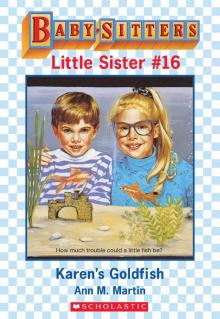 Karen's Goldfish
Karen's Goldfish Snow War
Snow War Abby and the Secret Society
Abby and the Secret Society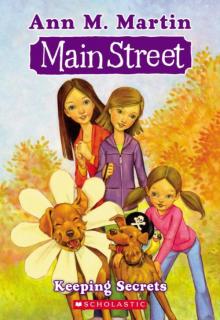 Keeping Secrets
Keeping Secrets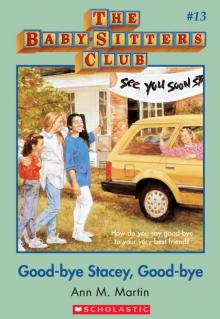 Good-Bye Stacey, Good-Bye
Good-Bye Stacey, Good-Bye Karen's Sleepover
Karen's Sleepover Claudia and the World's Cutest Baby
Claudia and the World's Cutest Baby Mary Anne Saves the Day
Mary Anne Saves the Day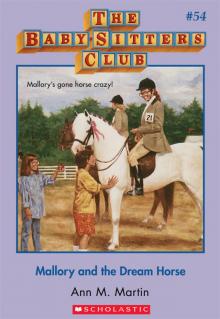 Mallory and the Dream Horse
Mallory and the Dream Horse Kristy and the Mystery Train
Kristy and the Mystery Train Dawn's Family Feud
Dawn's Family Feud Karen's Twin
Karen's Twin Little Miss Stoneybrook... And Dawn
Little Miss Stoneybrook... And Dawn Karen's Mistake
Karen's Mistake Karen's Movie Star
Karen's Movie Star Mallory and the Mystery Diary
Mallory and the Mystery Diary Karen's Monsters
Karen's Monsters Kristy + Bart = ?
Kristy + Bart = ? Karen's Dinosaur
Karen's Dinosaur Here Today
Here Today Karen's Carnival
Karen's Carnival How to Look for a Lost Dog
How to Look for a Lost Dog Stacey vs. Claudia
Stacey vs. Claudia Stacey's Ex-Boyfriend
Stacey's Ex-Boyfriend Here Come the Bridesmaids!
Here Come the Bridesmaids!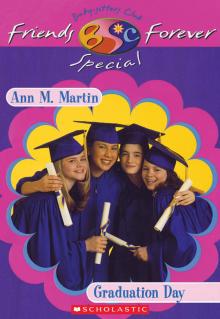 Graduation Day
Graduation Day Kristy's Big News
Kristy's Big News Karen's School Surprise
Karen's School Surprise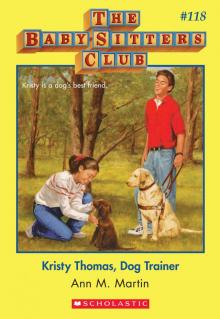 Kristy Thomas, Dog Trainer
Kristy Thomas, Dog Trainer Baby-Sitters' Christmas Chiller
Baby-Sitters' Christmas Chiller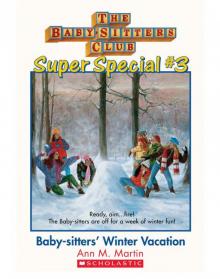 Baby-Sitters' Winter Vacation
Baby-Sitters' Winter Vacation Ten Good and Bad Things About My Life
Ten Good and Bad Things About My Life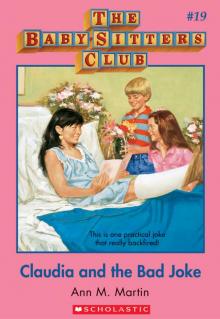 Claudia and the Bad Joke
Claudia and the Bad Joke Mary Anne's Makeover
Mary Anne's Makeover Stacey and the Fashion Victim
Stacey and the Fashion Victim Dawn Schafer, Undercover Baby-Sitter
Dawn Schafer, Undercover Baby-Sitter Karen's Tuba
Karen's Tuba Dawn's Wicked Stepsister
Dawn's Wicked Stepsister Diary Three: Dawn, Sunny, Maggie, Amalia, and Ducky
Diary Three: Dawn, Sunny, Maggie, Amalia, and Ducky Karen's Nanny
Karen's Nanny Jessi and the Awful Secret
Jessi and the Awful Secret Karen's New Year
Karen's New Year Karen's Candy
Karen's Candy Karen's President
Karen's President Mary Anne and the Great Romance
Mary Anne and the Great Romance Mary Anne + 2 Many Babies
Mary Anne + 2 Many Babies Kristy and the Copycat
Kristy and the Copycat Jessi and the Bad Baby-Sitter
Jessi and the Bad Baby-Sitter Claudia, Queen of the Seventh Grade
Claudia, Queen of the Seventh Grade Claudia and the Lighthouse Ghost
Claudia and the Lighthouse Ghost Karen's New Puppy
Karen's New Puppy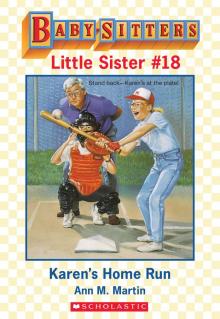 Karen's Home Run
Karen's Home Run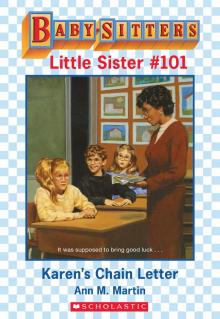 Karen's Chain Letter
Karen's Chain Letter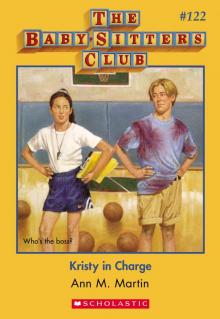 Kristy in Charge
Kristy in Charge Karen's Angel
Karen's Angel Mary Anne and Too Many Boys
Mary Anne and Too Many Boys Karen's Big Fight
Karen's Big Fight Karen's Spy Mystery
Karen's Spy Mystery Stacey's Big Crush
Stacey's Big Crush Karen's School
Karen's School Claudia and the Terrible Truth
Claudia and the Terrible Truth Karen's Cowboy
Karen's Cowboy The Summer Before
The Summer Before Beware, Dawn!
Beware, Dawn! Belle Teale
Belle Teale Claudia's Big Party
Claudia's Big Party The Secret Life of Mary Anne Spier
The Secret Life of Mary Anne Spier Karen's Book
Karen's Book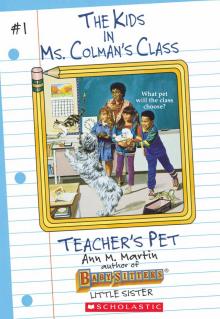 Teacher's Pet
Teacher's Pet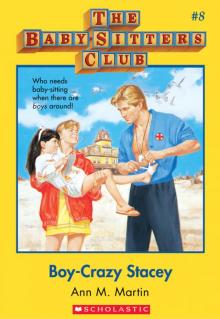 Boy-Crazy Stacey
Boy-Crazy Stacey Claudia and the Disaster Date
Claudia and the Disaster Date Author Day
Author Day Claudia and the Sad Good-Bye
Claudia and the Sad Good-Bye Kristy and the Worst Kid Ever
Kristy and the Worst Kid Ever Yours Turly, Shirley
Yours Turly, Shirley Class Play
Class Play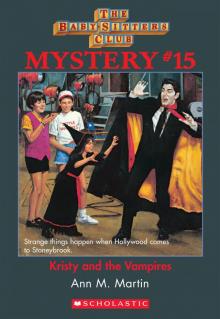 Kristy and the Vampires
Kristy and the Vampires Kristy and the Cat Burglar
Kristy and the Cat Burglar Karen's Pumpkin Patch
Karen's Pumpkin Patch Stacey and the Mystery at the Empty House
Stacey and the Mystery at the Empty House Karen's Chicken Pox
Karen's Chicken Pox Mary Anne and the Playground Fight
Mary Anne and the Playground Fight Stacey's Mistake
Stacey's Mistake Coming Apart
Coming Apart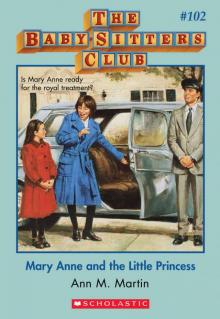 Mary Anne and the Little Princess
Mary Anne and the Little Princess Karen, Hannie and Nancy: The Three Musketeers
Karen, Hannie and Nancy: The Three Musketeers 'Tis the Season
'Tis the Season Claudia and Mean Janine
Claudia and Mean Janine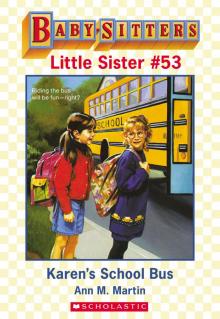 Karen's School Bus
Karen's School Bus Mary Anne's Big Breakup
Mary Anne's Big Breakup Rain Reign
Rain Reign Claudia and the Mystery at the Museum
Claudia and the Mystery at the Museum Claudia and the Great Search
Claudia and the Great Search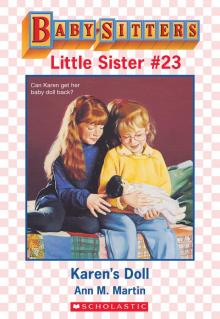 Karen's Doll
Karen's Doll Shannon's Story
Shannon's Story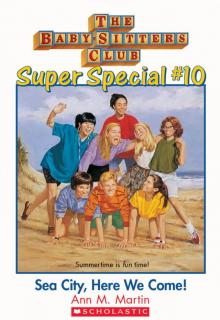 Sea City, Here We Come!
Sea City, Here We Come! Stacey and the Mystery of Stoneybrook
Stacey and the Mystery of Stoneybrook Karen's Treasure
Karen's Treasure Ten Rules for Living With My Sister
Ten Rules for Living With My Sister With You and Without You
With You and Without You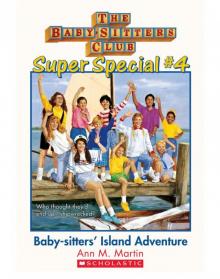 Baby-Sitters' Island Adventure
Baby-Sitters' Island Adventure Karen's Fishing Trip
Karen's Fishing Trip Dawn and the Big Sleepover
Dawn and the Big Sleepover New York, New York!
New York, New York! Ten Kids, No Pets
Ten Kids, No Pets Happy Holidays, Jessi
Happy Holidays, Jessi Halloween Parade
Halloween Parade Karen's New Holiday
Karen's New Holiday Kristy Power!
Kristy Power! Karen's Wish
Karen's Wish Claudia and the Mystery in the Painting
Claudia and the Mystery in the Painting Karen's Stepmother
Karen's Stepmother Abby in Wonderland
Abby in Wonderland Karen's Snow Day
Karen's Snow Day Kristy and the Secret of Susan
Kristy and the Secret of Susan Karen's Pony Camp
Karen's Pony Camp Karen's School Trip
Karen's School Trip Mary Anne to the Rescue
Mary Anne to the Rescue Karen's Unicorn
Karen's Unicorn Abby and the Notorious Neighbor
Abby and the Notorious Neighbor Stacey and the Haunted Masquerade
Stacey and the Haunted Masquerade Claudia Gets Her Guy
Claudia Gets Her Guy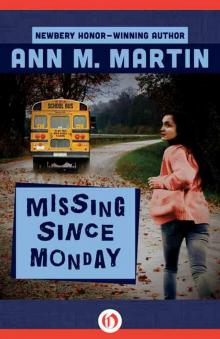 Missing Since Monday
Missing Since Monday Stacey's Choice
Stacey's Choice Stacey's Ex-Best Friend
Stacey's Ex-Best Friend Karen's New Teacher
Karen's New Teacher Karen's Accident
Karen's Accident Karen's Lucky Penny
Karen's Lucky Penny Karen's Cartwheel
Karen's Cartwheel Karen's Puppet Show
Karen's Puppet Show Spelling Bee
Spelling Bee Stacey's Problem
Stacey's Problem Stacey and the Stolen Hearts
Stacey and the Stolen Hearts Karen's Surprise
Karen's Surprise Karen's Worst Day
Karen's Worst Day The Ghost at Dawn's House
The Ghost at Dawn's House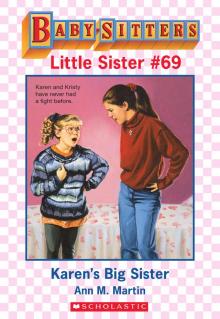 Karen's Big Sister
Karen's Big Sister Karen's Easter Parade
Karen's Easter Parade Mary Anne and the Silent Witness
Mary Anne and the Silent Witness Karen's Swim Meet
Karen's Swim Meet Mary Anne's Revenge
Mary Anne's Revenge Karen's Mystery
Karen's Mystery Stacey and the Mystery Money
Stacey and the Mystery Money Dawn and the Disappearing Dogs
Dawn and the Disappearing Dogs Karen's Christmas Tree
Karen's Christmas Tree Welcome to Camden Falls
Welcome to Camden Falls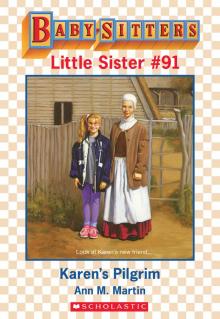 Karen's Pilgrim
Karen's Pilgrim Dawn and the Halloween Mystery
Dawn and the Halloween Mystery Mary Anne in the Middle
Mary Anne in the Middle Karen's Toys
Karen's Toys Kristy's Great Idea
Kristy's Great Idea Claudia and the Middle School Mystery
Claudia and the Middle School Mystery Karen's Big Weekend
Karen's Big Weekend Logan's Story
Logan's Story Karen's Yo-Yo
Karen's Yo-Yo Kristy's Book
Kristy's Book Mallory and the Ghost Cat
Mallory and the Ghost Cat Mary Anne and the Music
Mary Anne and the Music Karen's Tattletale
Karen's Tattletale Karen's County Fair
Karen's County Fair Karen's Mermaid
Karen's Mermaid Snowbound
Snowbound Karen's Movie
Karen's Movie Jessi and the Troublemaker
Jessi and the Troublemaker Baby-Sitters at Shadow Lake
Baby-Sitters at Shadow Lake Mallory on Strike
Mallory on Strike Jessi's Baby-Sitter
Jessi's Baby-Sitter Karen's Leprechaun
Karen's Leprechaun Claudia and the Phantom Phone Calls
Claudia and the Phantom Phone Calls Karen's Good-Bye
Karen's Good-Bye Karen's Figure Eight
Karen's Figure Eight Logan Likes Mary Anne!
Logan Likes Mary Anne! Mary Anne and the Zoo Mystery
Mary Anne and the Zoo Mystery Missy Piggle-Wiggle and the Whatever Cure
Missy Piggle-Wiggle and the Whatever Cure Dawn on the Coast
Dawn on the Coast Stacey and the Cheerleaders
Stacey and the Cheerleaders Claudia and the Clue in the Photograph
Claudia and the Clue in the Photograph Karen's New Friend
Karen's New Friend Mallory and the Trouble With Twins
Mallory and the Trouble With Twins Karen's Roller Skates
Karen's Roller Skates Abby and the Best Kid Ever
Abby and the Best Kid Ever Poor Mallory!
Poor Mallory! Karen's Witch
Karen's Witch Karen's Grandmothers
Karen's Grandmothers Slam Book
Slam Book Karen's School Picture
Karen's School Picture Karen's Reindeer
Karen's Reindeer Kristy's Big Day
Kristy's Big Day The Long Way Home
The Long Way Home Karen's Sleigh Ride
Karen's Sleigh Ride On Christmas Eve
On Christmas Eve Karen's Copycat
Karen's Copycat Karen's Ice Skates
Karen's Ice Skates Claudia and the Little Liar
Claudia and the Little Liar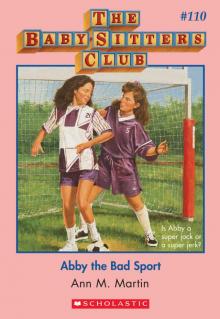 Abby the Bad Sport
Abby the Bad Sport The Baby-Sitters Club #5: Dawn and the Impossible Three
The Baby-Sitters Club #5: Dawn and the Impossible Three Abby's Book
Abby's Book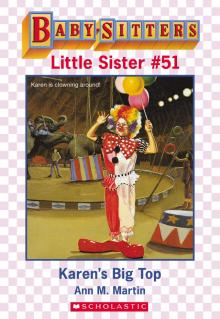 Karen's Big Top
Karen's Big Top Main Street #8: Special Delivery
Main Street #8: Special Delivery Kristy and the Kidnapper
Kristy and the Kidnapper Karen's Ski Trip
Karen's Ski Trip Karen's Hurricane
Karen's Hurricane Stacey and the Mystery at the Mall
Stacey and the Mystery at the Mall Jessi and the Superbrat
Jessi and the Superbrat Kristy and the Baby Parade
Kristy and the Baby Parade Karen's New Bike
Karen's New Bike Karen's Big City Mystery
Karen's Big City Mystery Baby-Sitters' European Vacation
Baby-Sitters' European Vacation Hello, Mallory
Hello, Mallory Dawn's Big Date
Dawn's Big Date Karen's Christmas Carol
Karen's Christmas Carol Jessi's Horrible Prank
Jessi's Horrible Prank Kristy and the Missing Fortune
Kristy and the Missing Fortune Kristy and the Haunted Mansion
Kristy and the Haunted Mansion Jessi's Big Break
Jessi's Big Break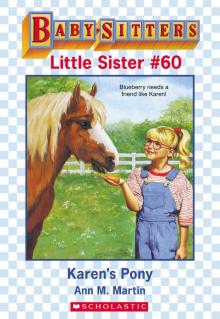 Karen's Pony
Karen's Pony Welcome Home, Mary Anne
Welcome Home, Mary Anne Stacey the Math Whiz
Stacey the Math Whiz September Surprises
September Surprises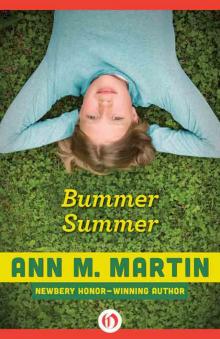 Bummer Summer
Bummer Summer Karen's Secret
Karen's Secret Abby's Twin
Abby's Twin Main Street #4: Best Friends
Main Street #4: Best Friends Karen's Big Move
Karen's Big Move Mary Anne Misses Logan
Mary Anne Misses Logan Stacey's Book
Stacey's Book Claudia and the Perfect Boy
Claudia and the Perfect Boy Holiday Time
Holiday Time Stacey's Broken Heart
Stacey's Broken Heart Karen's Field Day
Karen's Field Day Kristy's Worst Idea
Kristy's Worst Idea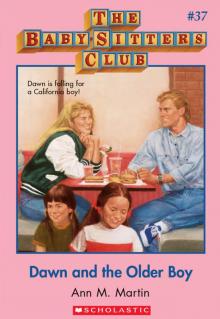 Dawn and the Older Boy
Dawn and the Older Boy Karen's Brothers
Karen's Brothers Claudia's Friend
Claudia's Friend Mary Anne and the Haunted Bookstore
Mary Anne and the Haunted Bookstore Dawn and Whitney, Friends Forever
Dawn and Whitney, Friends Forever Summer School
Summer School Karen's Birthday
Karen's Birthday Karen's Black Cat
Karen's Black Cat Stacey McGill... Matchmaker?
Stacey McGill... Matchmaker? Claudia's Book
Claudia's Book Main Street #2: Needle and Thread
Main Street #2: Needle and Thread Karen's Runaway Turkey
Karen's Runaway Turkey Karen's Campout
Karen's Campout Karen's Bunny
Karen's Bunny Claudia and the New Girl
Claudia and the New Girl Karen's Wedding
Karen's Wedding Karen's Promise
Karen's Promise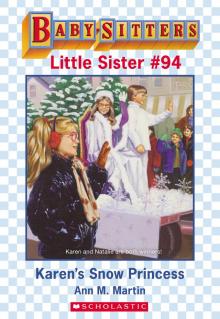 Karen's Snow Princess
Karen's Snow Princess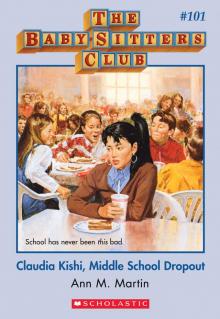 Claudia Kishi, Middle School Dropout
Claudia Kishi, Middle School Dropout Starring the Baby-Sitters Club!
Starring the Baby-Sitters Club! Kristy for President
Kristy for President California Girls!
California Girls! Maid Mary Anne
Maid Mary Anne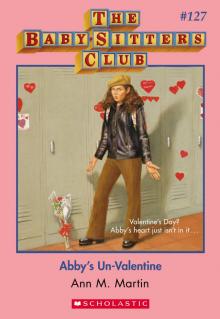 Abby's Un-Valentine
Abby's Un-Valentine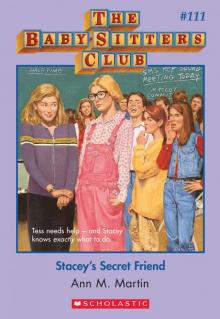 Stacey's Secret Friend
Stacey's Secret Friend Karen's Haunted House
Karen's Haunted House Claudia and Crazy Peaches
Claudia and Crazy Peaches Karen's Prize
Karen's Prize Get Well Soon, Mallory!
Get Well Soon, Mallory! Karen's Doll Hospital
Karen's Doll Hospital Karen's Newspaper
Karen's Newspaper Karen's Toothache
Karen's Toothache Mary Anne and Miss Priss
Mary Anne and Miss Priss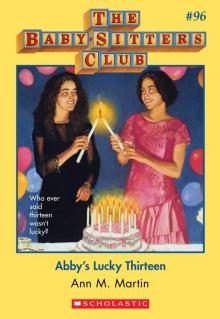 Abby's Lucky Thirteen
Abby's Lucky Thirteen The Secret Book Club
The Secret Book Club The All-New Mallory Pike
The All-New Mallory Pike Karen's Turkey Day
Karen's Turkey Day Karen's Magician
Karen's Magician Mary Anne and the Library Mystery
Mary Anne and the Library Mystery Diary One: Dawn, Sunny, Maggie, Amalia, and Ducky
Diary One: Dawn, Sunny, Maggie, Amalia, and Ducky Mary Anne and the Secret in the Attic
Mary Anne and the Secret in the Attic Kristy and the Mother's Day Surprise
Kristy and the Mother's Day Surprise Karen's in Love
Karen's in Love Welcome to the BSC, Abby
Welcome to the BSC, Abby Karen's Kittycat Club
Karen's Kittycat Club The Mystery at Claudia's House
The Mystery at Claudia's House The Truth About Stacey
The Truth About Stacey Karen's Bully
Karen's Bully Karen's Gift
Karen's Gift BSC in the USA
BSC in the USA Everything for a Dog
Everything for a Dog Dawn and the We Love Kids Club
Dawn and the We Love Kids Club Karen's Ghost
Karen's Ghost Stacey's Lie
Stacey's Lie Jessi's Secret Language
Jessi's Secret Language Kristy and the Missing Child
Kristy and the Missing Child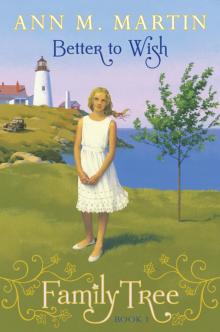 Better to Wish
Better to Wish Baby-Sitters on Board!
Baby-Sitters on Board! Kristy at Bat
Kristy at Bat Everything Changes
Everything Changes Don't Give Up, Mallory
Don't Give Up, Mallory A Dog's Life: The Autobiography of a Stray
A Dog's Life: The Autobiography of a Stray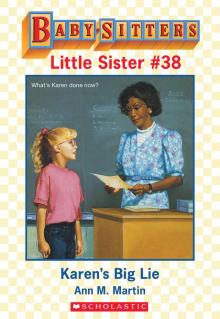 Karen's Big Lie
Karen's Big Lie Karen's Show and Share
Karen's Show and Share Mallory Hates Boys (and Gym)
Mallory Hates Boys (and Gym) Diary Two: Dawn, Sunny, Maggie, Amalia, and Ducky
Diary Two: Dawn, Sunny, Maggie, Amalia, and Ducky Karen's Pen Pal
Karen's Pen Pal Claudia and the Friendship Feud
Claudia and the Friendship Feud Karen's Secret Valentine
Karen's Secret Valentine Keep Out, Claudia!
Keep Out, Claudia!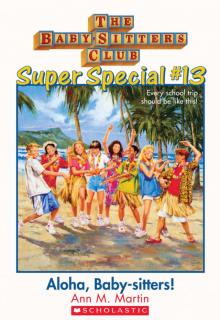 Aloha, Baby-Sitters!
Aloha, Baby-Sitters! Welcome Back, Stacey
Welcome Back, Stacey Jessi Ramsey, Pet-Sitter
Jessi Ramsey, Pet-Sitter Karen's Pizza Party
Karen's Pizza Party Kristy and the Dirty Diapers
Kristy and the Dirty Diapers Staying Together
Staying Together Dawn and the Surfer Ghost
Dawn and the Surfer Ghost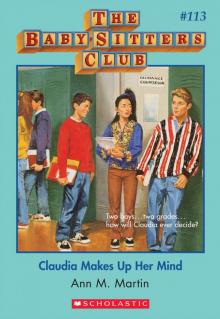 Claudia Makes Up Her Mind
Claudia Makes Up Her Mind Jessi's Gold Medal
Jessi's Gold Medal Karen's Kite
Karen's Kite Baby Animal Zoo
Baby Animal Zoo Dawn's Big Move
Dawn's Big Move Karen's Big Joke
Karen's Big Joke Karen's Lemonade Stand
Karen's Lemonade Stand Ma and Pa Dracula
Ma and Pa Dracula Baby-Sitters' Haunted House
Baby-Sitters' Haunted House Abby and the Mystery Baby
Abby and the Mystery Baby Home Is the Place
Home Is the Place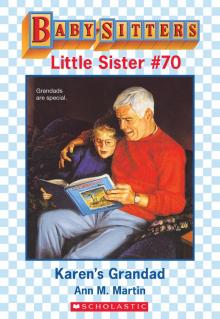 Karen's Grandad
Karen's Grandad Twin Trouble
Twin Trouble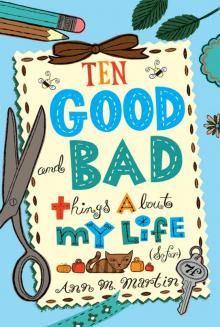 Ten Good and Bad Things About My Life (So Far)
Ten Good and Bad Things About My Life (So Far) Diary Two
Diary Two Baby-Sitters Club 027
Baby-Sitters Club 027 Claudia and the Mystery Painting
Claudia and the Mystery Painting Diary One
Diary One Baby-Sitters Club 037
Baby-Sitters Club 037 Baby-Sitters Club 028
Baby-Sitters Club 028 Baby-Sitters Club 085
Baby-Sitters Club 085 Dawn Schaffer Undercover Baby-Sitter
Dawn Schaffer Undercover Baby-Sitter Jessi's Babysitter
Jessi's Babysitter The Baby-Sitters Club #110: Abby the Bad Sport (Baby-Sitters Club, The)
The Baby-Sitters Club #110: Abby the Bad Sport (Baby-Sitters Club, The) Karen's Little Sister
Karen's Little Sister Baby-Sitters Club 058
Baby-Sitters Club 058 Claudia And The Genius On Elm St.
Claudia And The Genius On Elm St. Missy Piggle-Wiggle and the Sticky-Fingers Cure
Missy Piggle-Wiggle and the Sticky-Fingers Cure Kristy and Kidnapper
Kristy and Kidnapper Baby-Sitters Club 041
Baby-Sitters Club 041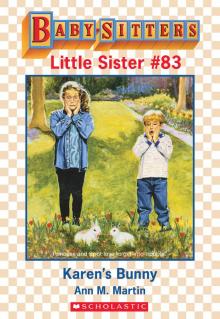 Karen's Bunny Trouble
Karen's Bunny Trouble Baby-Sitters Club 032
Baby-Sitters Club 032 Diary Three
Diary Three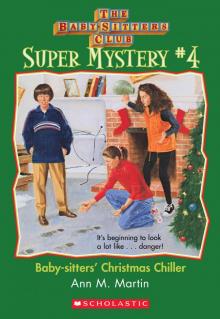 Christmas Chiller
Christmas Chiller Karen's Half-Birthday
Karen's Half-Birthday Needle and Thread
Needle and Thread Secret Life of Mary Anne Spier
Secret Life of Mary Anne Spier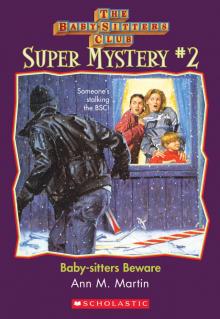 Baby-Sitters Beware
Baby-Sitters Beware Claudia Kishi, Middle School Drop-Out
Claudia Kishi, Middle School Drop-Out Logan Likes Mary Anne !
Logan Likes Mary Anne ! Baby-Sitters Club 061
Baby-Sitters Club 061 Best Friends
Best Friends Baby-Sitters Club 031
Baby-Sitters Club 031 Karen's Little Witch
Karen's Little Witch Jessi Ramsey, Petsitter
Jessi Ramsey, Petsitter Baby-Sitters Club 123
Baby-Sitters Club 123 Baby-Sitters Club 059
Baby-Sitters Club 059 Baby-Sitters Club 033
Baby-Sitters Club 033 Baby-Sitters Club 060
Baby-Sitters Club 060 Baby-Sitters Club 094
Baby-Sitters Club 094 The Baby-Sitters Club #99: Stacey's Broken Heart
The Baby-Sitters Club #99: Stacey's Broken Heart The Baby-Sitters Club #109: Mary Anne to the Rescue (Baby-Sitters Club, The)
The Baby-Sitters Club #109: Mary Anne to the Rescue (Baby-Sitters Club, The) Mystery At Claudia's House
Mystery At Claudia's House Claudia And The Sad Goodbye
Claudia And The Sad Goodbye Mary Anne's Big Break-Up
Mary Anne's Big Break-Up Baby-Sitters Club 025
Baby-Sitters Club 025 Baby-Sitters Club 042
Baby-Sitters Club 042 Stacey and the Mystery of the Empty House
Stacey and the Mystery of the Empty House Karen's Baby-Sitter
Karen's Baby-Sitter Claudia's Friendship Feud
Claudia's Friendship Feud Baby-Sitters Club 090
Baby-Sitters Club 090 Baby-Sitters Club 021
Baby-Sitters Club 021 Baby-Sitters Club 056
Baby-Sitters Club 056 Baby-Sitters Club 040
Baby-Sitters Club 040 The Baby-Sitters Club #108: Don't Give Up, Mallory (Baby-Sitters Club, The)
The Baby-Sitters Club #108: Don't Give Up, Mallory (Baby-Sitters Club, The) Dawn and the Impossible Three
Dawn and the Impossible Three The Snow War
The Snow War Special Delivery
Special Delivery Baby-Sitters Club 057
Baby-Sitters Club 057 Mary Anne And Too Many Babies
Mary Anne And Too Many Babies Baby-Sitters Club 030
Baby-Sitters Club 030